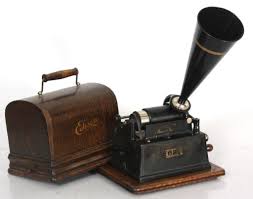Record Albums
The American Treasure Tour has thousands of classic 1960's, '70's, and '80's record albums on display in the Music Room and throughout the tour. Look for your favorite Village People or Willie Nelson album on our Record Wall!
You will find an endless opportunity to access information on this page. Included, we have a brief - and fascinating! - history of early phonographs, as well as stories behind some of the actual albums displayed!
Phonograph Cylinder - Thomas Edison was one of the world's greatest and most successful tinkerers. He would develop a new idea for technology and, if he thought it might make him money, had his staff of inventors perfect it. If it didn't, it got pushed to the side and either completely abandoned or picked up again later by him, his people, or the competition. He first patented his phonograph in the year 1877. At this time, he recorded sound on thin, flimsy sheets of tin foil wrapped around a hand-cranked, grooved metal cylinder. It was cool, but nothing more than a plaything with no real applicable use. He lost interest and moved on to such innovations as practical electricity and light bulbs. Meanwhile, Alexander Graham Bell and cohorts at the Volta Laboratory caught wind of what he did with sound technology, and started experimenting with wax as a form of recording device to capture - and preserve – sound instead of foil. They introduced the "Graphophone" in 1887. It worked. When Edison learned about it, he got back in the game and improved on Volta’s improvements. Then, he signed a patent-sharing agreement with Volta and got to make the technology even better. By 1889, they were selling hard-wax cylinders with music permanently etched into the grooves for people to listen to, usually at nickelodeons (literally “nickel theaters”) and other entertainment sites. They held about two minutes' worth of music, and were a phenomenon of the era. By 1900, an early form of hard plastic was developed called celluloid that improved upon the wax cylinders. They proved more durable than anything before them, and many forms of sound preservation after them, but they could only preserve up to four minutes' worth of music. Despite their short recording time, they remained the most popular method for music reproduction until the early 19-teens. But 1901 saw the introduction of a new type of musical storage device, the disc.
Shellac & Vinyl Records - The recording of sound by Thomas Edison on flimsy aluminum evolved into wax cylinders, each of which stored somewhere around four minutes' worth of music, talking, or whatever was desired. Surprisingly, the first discs were developed as early as 1889, but exclusively in Europe. The inventor was a man named Emile Berliner, and the discs were five inches wide, played on hand-cranked machines he called 'gramophones.' They were only used as toys, until Berliner brought more sophisticated discs to the United States by 1894. Along with his American business partner Eldridge R. Johnson, Berliner improved the size and quality of his discs. They called their business the Victor Talking Machine Company. In 1901, they produced 10" records, and in 1903 their 12" records became the standard that inspired imitators, although the speed and length of records varied for many years. It was not until 1925 that the speed of records became truly standardized at 78 rotations per minute (rpm) with no more than ten minutes' worth of music on an album. These albums were generally made using shellac (also used as a lacquer for wood) and pulverized rocks and minerals. Plastic was being developed around this time, though, and by 1931, vinyl began to appear in records. Although more vulnerable to scratches than the 78 rpm shellac, the vinyl allowed more information to be included on the album. Moving at 33-1/3 rpm's, long-playing vinyl records could hold up to thirty minutes' worth of music on each side, while smaller 45 rpm records held about ten minutes on each side. The Great Depression made mass-production of these new records impractical, so Americans really didn't get to enjoy the new technology until after World War II. But they created a revolution in music after that, with vinyl records maintaining dominance in the music industry through the 1970's. From there, 8-track and analog audiocassettes began to dominate, prior to the advent of the digital technology still used today (compact discs and digital downloads being the primary source for pre-recorded music right now).



















